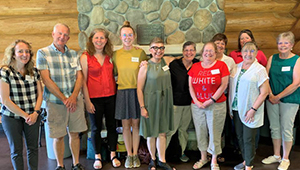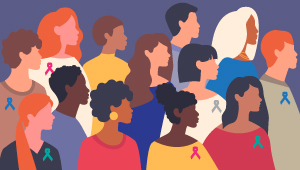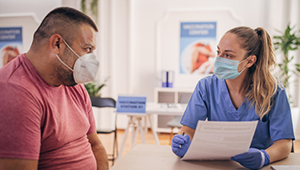Helping first-time screeners know when to return
A "patient voices" video was created as part of a communication intervention to increase awareness about lung cancer screening and annual follow-up for people who recently had screening. Video produced by Artefact.
Well-timed outreach in print and video can boost awareness of repeat screening for lung cancer, study finds
Lung cancer screening saves lives, but it needs to be repeated annually to detect early-stage cancers, and many people who’ve had screening don’t return each year. A new study from Kaiser Permanente Washington Health Research Institute (KPWHRI) suggests that additional communication — with print materials and video — can boost people’s awareness about repeat screening and when to get it.
What do we know already?
Lung cancer is the leading cause of death from cancer in the United States, resulting in more deaths than colon, breast, and cervical cancers combined.
Annual screening with a low-dose computed tomography (CT) scan can detect lung cancer at an early stage, when it is more treatable. Screening is recommended for adults who are at high risk of the disease because of their age and tobacco history, but adherence is low: Even among people who have had screening, less than half return for repeat scans. Research suggests that one reason is lack of awareness that lung cancer screening is not a one-time test but involves returning for yearly scans.
To improve adherence to lung cancer screening, researchers at KPWHRI collaborated with a patient advisory board as well as primary care physicians and leaders to understand the challenges and barriers to screening from the patient's and provider’s perspective. With the help of a design firm (Artefact), these partnerships produced a communication intervention for people who had recently had screening, combining print materials with a “patient voices” video (see above). Together, these communication tools emphasized 3 key messages:
- Participating in lung cancer screening is an important step in taking care of your health by finding lung cancer early.
- You are due for your next lung scan in 12 months.
- Talking with friends and family about screening might help you feel supported in doing something positive for your health.
The researchers then conducted a randomized clinical trial to evaluate the impact of this intervention.
What did the new study find?
The study, published in the journal CHEST, included Kaiser Permanente Washington members ages 50 to 78 who completed lung cancer screening with normal results between November 2022 and April 2024. They were randomly divided into 2 groups:
- One group received the communication intervention within 3 weeks of their screening. It was delivered through Kaiser Permanente Washington’s electronic health record via a patient portal and mailed letters, with either an embedded link or QR code for the video.
- The other group received no additional communication.
Eight weeks after screening, both groups were invited to complete an online or telephone survey that assessed their knowledge of lung cancer screening and related topics. Of the 714 people who completed the survey, 363 had received the intervention and 351 had not. Among the key findings:
- Those who had received the intervention were 13% more likely to know to return in a year for screening than those who had not received the intervention.
- When the researchers looked separately at first-time screeners, the findings were particularly striking: Those who’d received the intervention were 35% more likely to know to return in a year. In contrast, the intervention didn’t significantly increase awareness among those who’d had screening 2 or more times.
“Our findings show that first-time screeners are a key group who could benefit from additional communication about annual follow-up, beyond the one-time shared decision-making with their doctor when they started screening,” said lead author Karen Wernli, PhD, a senior investigator at KPWHRI. “The communication strategies and key messages we developed with our patient partners were successfully delivered through the electronic health record, so they could be readily adapted by health systems seeking to strengthen their screening programs, even when working with limited resources.”
This research was supported by the National Cancer Institute, part of the National Institutes of Health.
KPWHRI coauthors on the study include Melissa Anderson, MS; Lorella Palazzo, PhD; Casey Luce, MSPH; Nadejda Bezman; Hongyuan Gao, MS; James Ralston, MD, MPH; Kristine Rogers, MS; Yu-Ru Su, PhD; Anjali Vasavada, MPH; and Beverly Green, MD, MPH. KPWHRI’s Survey Research Program provided recruitment and data collection for the study.
By Sophie Ramsey
Co-designing with patients

Patient collaboration sparks care innovations
By partnering with patients, KPWHRI researchers developed 2 new interventions to boost lung cancer screening.
Research

Improving cancer prevention and early detection
How KPWHRI is contributing to better cancer screening and better outcomes for patients.
Live healthy

What is shared decision-making?
An explanation from KPWHRI researchers about discussing treatment options with a medical provider.



